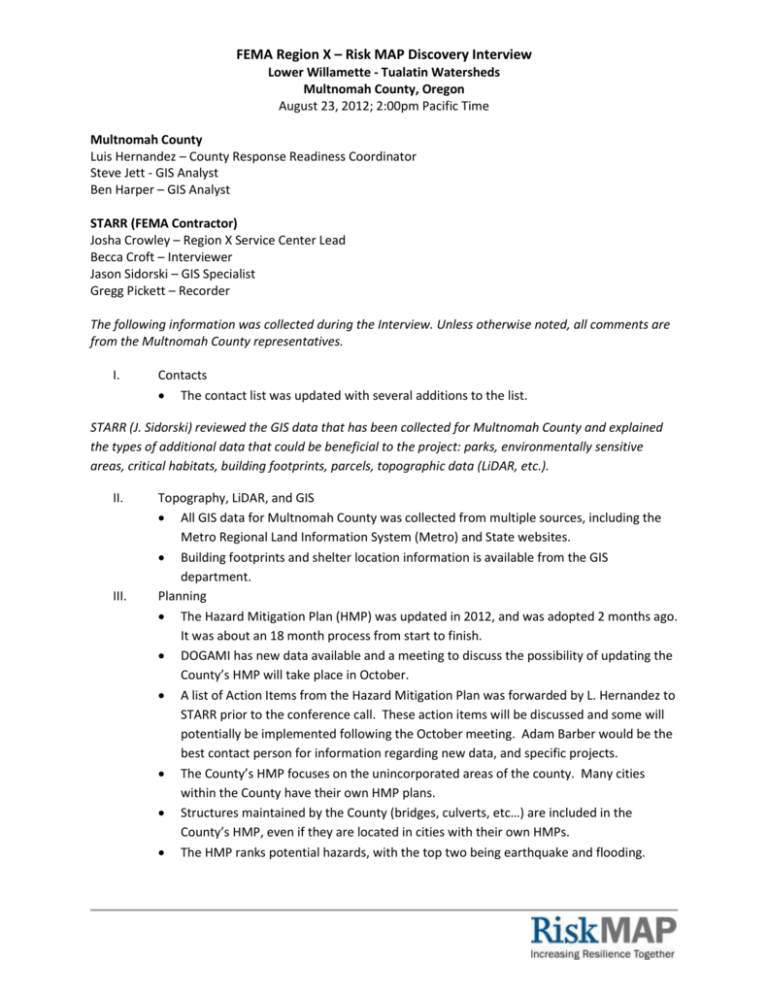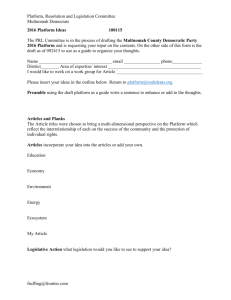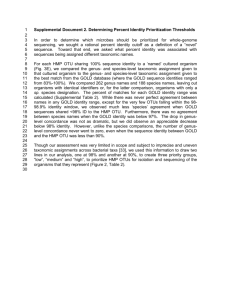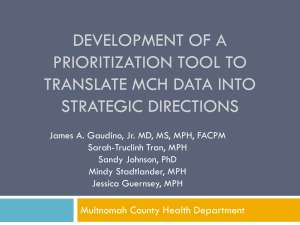FOR FEMA AND STATE REVIEW-MeetingMinutes-Multnomah
advertisement

FEMA Region X – Risk MAP Discovery Interview Lower Willamette - Tualatin Watersheds Multnomah County, Oregon August 23, 2012; 2:00pm Pacific Time Multnomah County Luis Hernandez – County Response Readiness Coordinator Steve Jett - GIS Analyst Ben Harper – GIS Analyst STARR (FEMA Contractor) Josha Crowley – Region X Service Center Lead Becca Croft – Interviewer Jason Sidorski – GIS Specialist Gregg Pickett – Recorder The following information was collected during the Interview. Unless otherwise noted, all comments are from the Multnomah County representatives. I. Contacts The contact list was updated with several additions to the list. STARR (J. Sidorski) reviewed the GIS data that has been collected for Multnomah County and explained the types of additional data that could be beneficial to the project: parks, environmentally sensitive areas, critical habitats, building footprints, parcels, topographic data (LiDAR, etc.). II. III. Topography, LiDAR, and GIS All GIS data for Multnomah County was collected from multiple sources, including the Metro Regional Land Information System (Metro) and State websites. Building footprints and shelter location information is available from the GIS department. Planning The Hazard Mitigation Plan (HMP) was updated in 2012, and was adopted 2 months ago. It was about an 18 month process from start to finish. DOGAMI has new data available and a meeting to discuss the possibility of updating the County’s HMP will take place in October. A list of Action Items from the Hazard Mitigation Plan was forwarded by L. Hernandez to STARR prior to the conference call. These action items will be discussed and some will potentially be implemented following the October meeting. Adam Barber would be the best contact person for information regarding new data, and specific projects. The County’s HMP focuses on the unincorporated areas of the county. Many cities within the County have their own HMP plans. Structures maintained by the County (bridges, culverts, etc…) are included in the County’s HMP, even if they are located in cities with their own HMPs. The HMP ranks potential hazards, with the top two being earthquake and flooding. Risk MAP Discovery Interview – Lower Willamette - Tualatin Watersheds Multnomah County – August 23, 2012 IV. V. Page 2 of 5 The County does not currently have an Evacuation Plan adopted, but mentioned that the City of Portland does. The County would like to revisit the idea of an evacuation plan, especially regarding volcanic hazards in and around the City of Troutdale. The Sauvie Island Bridge is currently being replaced. The County was not sure if this was the result of any hazard mitigation plan or not. Some culverts and transportation infrastructure, landslide mitigation, and road reinforcement to prevent landslides has taken place, but the County was unsure if this was directly related to the HMP. Chuck Beasley would be the best person to contact from the County regarding this. There is a meeting scheduled in October to review the current HMP. The October HMP Meeting is something that the County would like to discuss with the State and FEMA at the Discovery Meetings in late September. Earthquakes Multnomah County is located in the Cascadia Subduction Zone. Earthquake potential for the county is very similar to that of the city of Portland. The majority of unreinforced masonry buildings in the county are at risk, but most of these buildings are located in Portland. The Sellwood Bridge is being replaced because it is one of the worst performing bridges in the nation in regard to potential earthquake damage. The bridge also has existing structural problems that are a concern. A seismic retrofit of the county courthouse is needed in downtown Portland. A feasibility study was completed to determine how the work would be done while keeping the building open This is a current action item, and the County is interested in how to potentially get grant funds for that retrofit project. Wildfires The wildfire threat is a concern to the County. Attempts are being made to find funding for fuel reduction projects. These areas have been identified by GIS analysis. Many areas in the county were designated as having a high or relatively high risk of wildfire. Critical facilities have not been specifically identified in regard to wildfire risk, but if they were, these areas might be candidates for fuel reduction projects. Forest Park area would be at the highest risk for wildfire, in the northwest part of the county. Homes that abut forest lands are at the highest risk, and typically are the farthest from response vehicles. A major rail area (annotated on the display map) was noted as a potential area of fire concern, because fires have occurred here previously. Wildfire data is available from the County, and can possibly be found on their website. Risk MAP Discovery Interview – Lower Willamette - Tualatin Watersheds Multnomah County – August 23, 2012 Page 3 of 5 STARR requested a copy of the Wildland Urban Interface plan for the County, if there was no link on the Emergency Management website for the County. VI. VII. VIII. Landslides DOGAMI has landslide data and historic landslide locations, and new data may be available soon. Different types of landslides are identified in the County’s existing HMP, including maps and data from DOGAMI. The West Hills, I-84 Corridor, and the Columbia River Gorge areas are probably at the highest risk of landslides. Homes have been covered in the past, especially in the Gorge. Severe Storms High winds are the most likely cause of storm damage, with the Gorge being the area with the highest risk. Significant ice storm damage does occur, with the Troutdale area being the most susceptible. Heavy snow in recent years has severely impacted the operations of the County and City of Portland. Heavy snow and blizzards are currently part of the existing HMP. Power outages are typically of short duration in the county. The Human Services Department sets up warming and cooling shelters, but otherwise shelters are seldom, if ever, needed. BRIDGE is a GIS-based tool used by the County. This system includes a multitude of layers and useful data. The Red Cross would be the source for more established shelters in disaster situations. Agreements with schools to be used at shelters are in place. Information to the public is available in different languages. FIRST CALL (somewhat similar to Reverse 911) can be used, and messages can be selectively chosen based on the area(s) at risk. FIRST CALL is subscriber-based. Reverse 911 was recently used because of some E. coli in water, and residents in specific areas were directed to boil their water. In another instance, chemicals were released from an industrial building, and homes in that area were warned of the danger. FIRST CALL can use email, text, cell phones, land lines, etc. Reverse 911 may only work with land lines using a public directory. The public is told of these services via media, twitter, outreach officials, churches, community-based organizations, etc. Flooding The current Flood Insurance Rate Maps (FIRMs) could really be improved if they were revised using LiDAR data. LiDAR flights occurred in 2004 and 2007. One of the flights had better resolution. This work was completed for specific projects and doesn’t cover the county in its entirety. There are no known county-driven plans to fly new LiDAR in place. Risk MAP Discovery Interview – Lower Willamette - Tualatin Watersheds Multnomah County – August 23, 2012 IX. X. XI. Page 4 of 5 There are no known areas with flood-related claims for structures or properties outside of Special Flood Hazard Areas (SFHAs) There are no known repetitive loss structures in the county. Mr. Kim Peoples, the Roads and Bridges Manager, would be the best person to contact regarding any new construction projects, and their potential effects on the existing FIRMs. C. Beasley would be the person to contact regarding any rapid growth areas, and their affect on the SFHAs. Mr. Beasley would also have knowledge about what other types of flooding exist in the County, including shallow flooding, ponds, culvert debris, etc. The Johnson Creek Watershed was mentioned as a serious area of concern for the County. Levees The Sauvie Island Levee is located in the northern portion of the County, along the Columbia River. Environmentally Sensitive Areas A wetlands layer is available from the State, and it is updated regularly. The County has a number of salmon-bearing rivers, including some with endangered species of salmon. GIS layers are also available for this. Communications and Outreach The Oregon Museum for Science and Industry (OMSI) created an exhibit called Nature Unleashed, and Multnomah County partnered with them on this effort. Exhibits focused on natural hazards and a community-based approach to preparedness. The County had a table set up at the exhibit and gave a presentation. Steve Bullock would be the primary County contact to learn more about this, and many other outreach efforts going on in the County. Face-to-face outreach is the primary method of getting word out about hazards and risk, and seems to be the most effective way to divulge important hazard information. This typically takes place at community and public meetings. The Multnomah County website has information on Community Preparedness Training and links to FEMA’s Independent Study Program, An In-Depth Guide to Citizen Preparedness. The County would like to receive tools and templates on how to better communicate risk to the public. There is no designated floodplain manager at the County. Most likely someone in the planning department is tasked with that job, in addition to their normal planning-related responsibilities. The specific person who handles this work was unknown. The County requested information regarding training, webinars, outreach materials, etc., and those materials should be directed to A. Barber. A. Barber subscribes to monthly STARR Region X newsletter; L. Hernandez is interested in subscribing to them. Risk MAP Discovery Interview – Lower Willamette - Tualatin Watersheds Multnomah County – August 23, 2012 XII. Other The County is interested in more information about grant funding. Page 5 of 5











